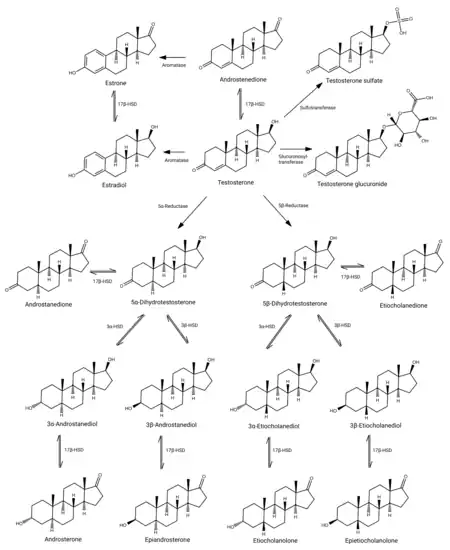Androgen conjugate
Testosterone metabolism in humans
|
An androgen conjugate is a conjugate of an androgen, such as testosterone.[1][2] They occur naturally in the body as metabolites of androgens.[1] Androgen conjugates include sulfate esters and glucuronide conjugates and are formed by sulfotransferase and glucuronosyltransferase enzymes, respectively.[1] In contrast to androgens, conjugates of androgens do not bind to the androgen receptor and are hormonally inactive. However, androgen conjugates can be converted back into active androgens through enzymes like steroid sulfatase.[3]
Examples of androgen conjugates include the sulfates testosterone sulfate, dehydroepiandrosterone sulfate, androstenediol sulfate, dihydrotestosterone sulfate, and androsterone sulfate, and the glucuronides testosterone glucuronide, dihydrotestosterone glucuronide, androsterone glucuronide, and androstanediol glucuronide.[1]
Androgen conjugates are conjugated at the C3 and/or C17β positions, where hydroxyl groups are available.[1]
See also
References
- 1 2 3 4 5 Kuuranne T (2010). "Phase-II metabolism of androgens and its relevance for doping control analysis". Doping in Sports. Handbook of Experimental Pharmacology. Vol. 195. pp. 65–75. doi:10.1007/978-3-540-79088-4_3. ISBN 978-3-540-79087-7. PMID 20020360.
- ↑ Rittmaster RS (January 1995). "Clinical relevance of testosterone and dihydrotestosterone metabolism in women". Am J Med. 98 (1A): 17S–21S. doi:10.1016/s0002-9343(99)80054-0. PMID 7825635.
- ↑ Day JM, Purohit A, Tutill HJ, Foster PA, Woo LW, Potter BV, Reed MJ (February 2009). "The development of steroid sulfatase inhibitors for hormone-dependent cancer therapy". Ann N Y Acad Sci. 1155 (1): 80–7. Bibcode:2009NYASA1155...80D. doi:10.1111/j.1749-6632.2008.03677.x. PMID 19250195. S2CID 25306673.
